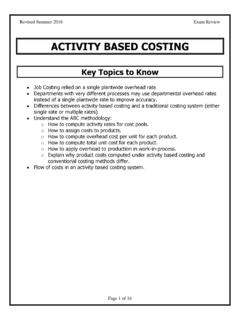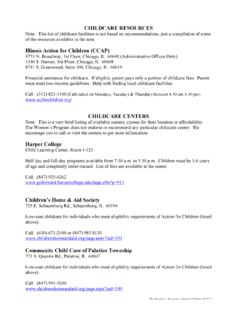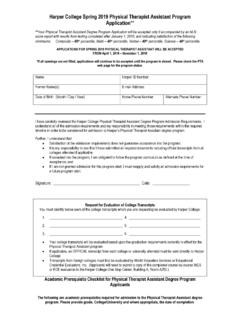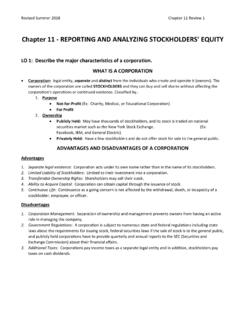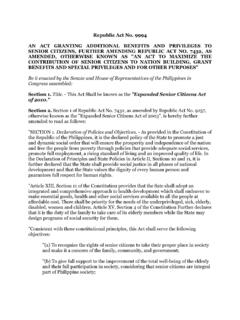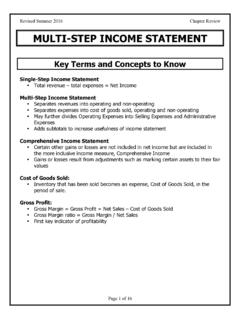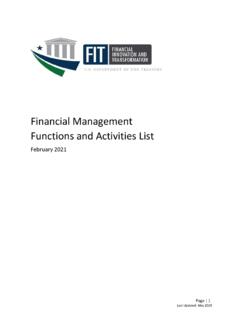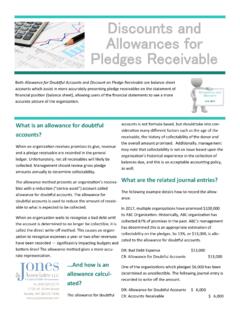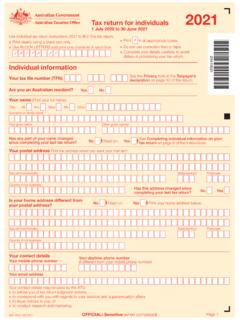Transcription of Chapter 8 Questions Multiple Choice
1 Chapter 8 Question Review 1 Chapter 8 Questions Multiple Choice 1. When customers make purchases with a national credit card, the retailer a. is responsible for maintaining customer accounts. b. is not involved in the collection process. c. absorbs any losses from uncollectible accounts. d. receives cash equal to the full price of the merchandise sold from the credit card company. 2. The two methods of accounting for uncollectible accounts are the direct write-off method and the a. Accrual Method b. Net Realizable Method c. Bad Debt Method d. allowance Method 3. A 90-day note dated April 20 would mature on a.
2 July 19 b. July 21 c. July 20 d. July 18 4. Under the direct write-off method of accounting for uncollectible accounts, Bad Debt Expense is debited a. when a credit sale is past due. b. at the end of each accounting period. c. whenever a pre-determined amount of credit sales have been made. d. when an account is determined to be uncollectible. 5. An aging of a company's accounts receivable indicates that $6,000 are estimated to be uncollectible. If allowance for Doubtful Accounts has a $2,000 debit balance, the adjustment to record bad debts for the period will require a a. debit to Bad Debt Expense for $8,000. b. debit to allowance for Doubtful Accounts for $8,000.
3 C. debit to Bad Debt Expense for $4,000. d. credit to allowance for Doubtful Accounts for $4,000. 6. The face value of a note refers to the amount a. that can be received if sold to a factor. b. borrowed plus interest received at maturity from the maker. c. at which the note receivable is recorded. d. remaining after a service charge has been deducted. 7. The interest on a $10,000, 9%, 90-day note receivable is a. $225. b. $900. c. $75. d. $150. Chapter 8 Question Review 2 8. Doane Company receives a $10,000, 3-month, 6% promissory note from Ray Company in settlement of an open accounts receivable. What entry will Doane Company make upon receiving the note?
4 A. Notes Receivable 10,150 Accounts Receivable Ray Company 10,150 b. Notes Receivable 10,150 Accounts Receivable Ray Company 10,000 Interest Revenue 150 c. Notes Receivable 10,000 Interest Receivable 150 Accounts Receivable Ray Company 10,000 Interest Revenue 150 d. Notes Receivable 10,000 Accounts Receivable Ray Company 10,000 9. A debit balance in the allowance for Doubtful Accounts a. is the normal balance for that account. b. indicates that actual bad debt write-offs have exceeded previous provisions for bad debts. c. indicates that actual bad debt write-offs have been less than what was estimated.
5 D. cannot occur if the percentage of receivables method of estimating bad debts is used. 10. When the allowance method of accounting for uncollectible accounts is used, Bad Debt Expense is recorded a. in the year after the credit sale is made. b. in the same year as the credit sale. c. as each credit sale is made. d. when an account is written off as uncollectible. 11. To record estimated uncollectible accounts using the allowance method, the adjusting entry would be a a. debit to Accounts Receivable and a credit to allowance for Doubtful Accounts. b. debit to Bad Debt Expense and a credit to allowance for Doubtful Accounts.
6 C. debit to allowance for Doubtful Accounts and a credit to Accounts Receivable. d. debit to Loss on Credit Sales and a credit to Accounts Receivable. 12. Using the percentage-of-receivables method for recording bad debt expense, estimated uncollectible accounts are $45,000. If the balance of the allowance for Doubtful Accounts is $6,000 credit before adjustment, what is the amount of bad debt expense for that period? a. $45,000 b. $39,000 c. $51,000 d. $6,000 Chapter 8 Question Review 3 13. Using the percentage-of-receivables method for recording bad debt expense, estimated uncollectible accounts are $45,000.
7 If the balance of the allowance for Doubtful Accounts is $6,000 debit before adjustment, what is the balance after adjustment? a. $45,000 b. $51,000 c. $39,000 d. $6,000 14. Non-trade receivables should be reported separately from trade receivables. Why is this statement either true or false? a. It is true because trade receivables are current assets and non-trade receivables are long term. b. It is false because all current receivables must be grouped together in one account. c. It is true because non-trade receivables do not result from business operations and should not be included with accounts receivable. d. It is false because management can decide how to report receivables.
8 15. In 20XX Wilkinson Company had net credit sales of $2,250,000. On January 1, 20XX, allowance for Doubtful Accounts had a credit balance of $54,000. During 20XX, $90,000 of uncollectible accounts receivable were written off. Past experience indicates that the allowance should be 10% of the balance in receivables (percentage of receivables basis). If the accounts receivable balance at December 31 was $600,000, what is the required adjustment to the allowance for Doubtful Accounts at December 31, 20XX? a. $ 60,000 b. $ 25,000 c. $ 96,000 d. $ 90,000 Chapter 8 Question Review 4 EXERCISES 1. Strickman Company uses the allowance method for estimating uncollectible accounts.
9 Prepare journal entries to record the following transactions: January 5 Sold merchandise to Sue Land for $1,800, terms n/15. April 15 Received $400 from Sue Land on account. August 21 Wrote off as uncollectible the balance of the Sue Land account when she declared bankruptcy. October 5 Unexpectedly received a check for $650 from Sue Land. 2. Compute the maturity value as indicated for each of the following notes receivable. A. A $9,000, 6%, 3-month note dated July 20. Maturity value $_____. B. A $16,000, 9%, 150-day note dated August 5. Maturity value $_____.
10 Date Debit Credit Chapter 8 Question Review 5 3. Merry Co. sells Christmas angels. Merry determines that at the end of December, they have the following aging schedule of Accounts Receivable: Customer Total Number of Days Past Due Not yet due 1 30 31 60 61 90 Over 90 K. Brant $500 $300 $200 D. Eaton 300 100 200 S Klein 150 50 100 C. Sheen 200 200 ? 300 300 250 200 100 % uncollectible 1% 5% 10% 25% 50% Total Estimated Uncollectible Amounts ? ? ? ?


